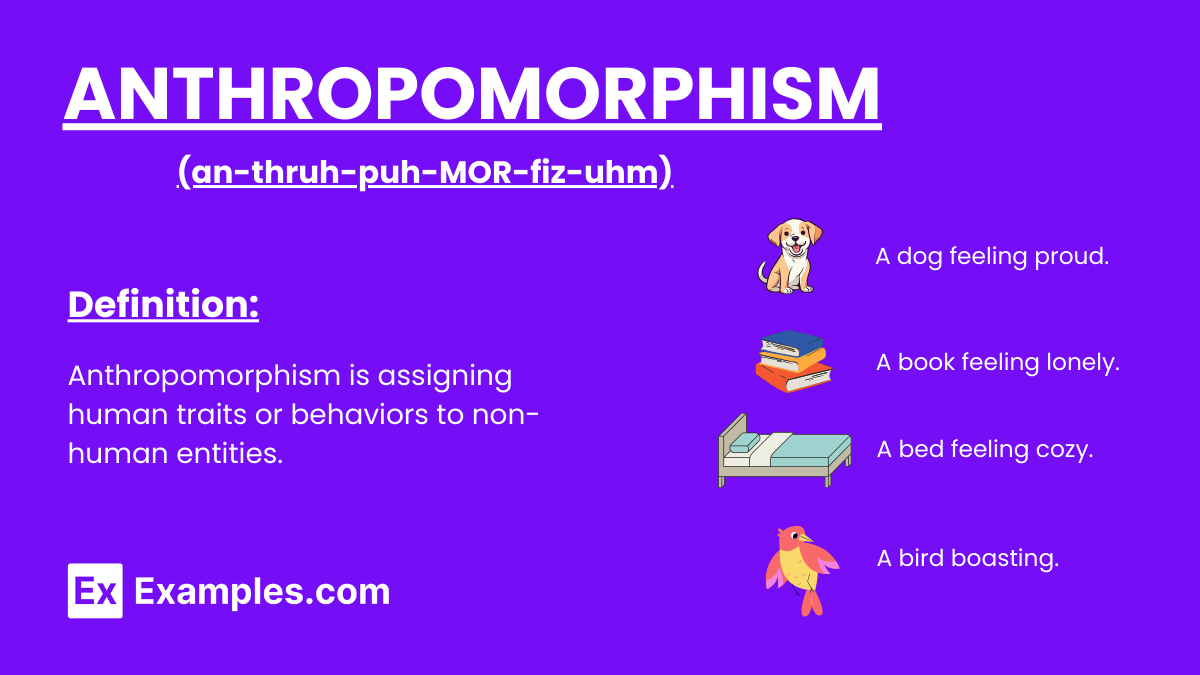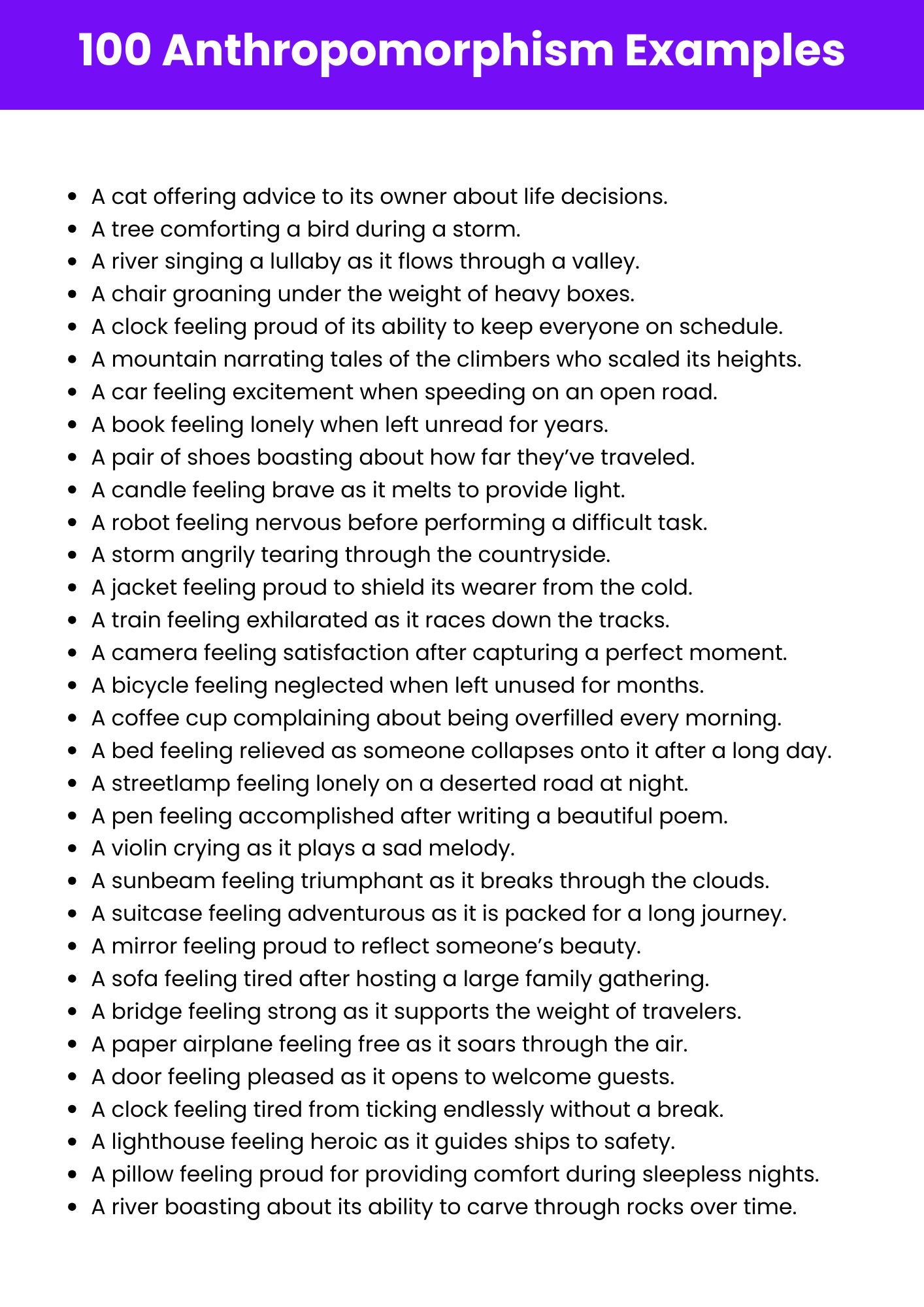Anthropomorphism
What is Anthropomorphism? – Definition
Anthropomorphism is the attribution of human characteristics, emotions, or behaviors to animals, objects, or deities, often used in literature and storytelling to create relatable narratives or convey abstract ideas.

Generated Anthropomorphism Examples

Download Anthropomorphism Examples
Enhance your understanding with our comprehensive PDF guide.
Download PDFExamples of Anthropomorphism
- A cat who narrates its daily adventures with human-like thoughts.
- A talking tree giving advice about the importance of nature.
- A cloud feeling sad as it rains over a lonely town.
- A star dreaming about shining brighter than the others.
- A flame dancing joyfully in a fireplace.
- A robot falling in love with a human companion.
- A squirrel plotting elaborate schemes to gather food.
- A lamp feeling proud when it brightens a room.
- A house sharing stories about the families who lived there.
- A river singing happily as it flows through a forest.
- A toy soldier bravely protecting its owner’s bedroom.
- A paintbrush describing its role in creating masterpieces.
- The moon feeling lonely in the vast night sky.
- A piano feeling excitement when played during a concert.
- A mountain telling stories of climbers who reached its peak.
- A car feeling neglected after being abandoned in a garage.
- A diary expressing its joy in keeping someone’s secrets.
- Raindrops giggling as they land on leaves during a storm.
- A theater curtain complaining about always being stepped on.
- A birthday cake feeling excitement as it’s about to be cut.
- A toy soldier bravely protecting its owner’s bedroom.
- A paintbrush describing its role in creating masterpieces.
- The moon feeling lonely in the vast night sky.
- A piano feeling excitement when played during a concert.
- A mountain telling stories of climbers who reached its peak.
- A car feeling neglected after being abandoned in a garage.
- A diary expressing its joy in keeping someone’s secrets.
- Raindrops giggling as they land on leaves during a storm.
- A theater curtain complaining about always being stepped on.
- A birthday cake feeling excitement as it’s about to be cut.
Types of Anthropomorphisms
Animal Anthropomorphism
Giving human traits or behaviors to animals, commonly used in fables and stories.
- A fox tricking other animals in a fable.
- A lion learning the value of kindness in a story.
- A group of mice planning how to bell a cat.
- A bird reflecting on its journey through migration.
- A dog expressing loyalty to its owner in a narrative.
Object Anthropomorphism
Attributing human qualities to inanimate objects.
- A clock complaining about always being watched.
- A teapot singing joyfully when boiling water.
- A chair feeling proud to provide comfort.
- A lamp feeling lonely when turned off.
- An hourglass feeling accomplished when flipped.
Nature Anthropomorphism
Humanizing elements of nature, like weather or landscapes.
- A mountain narrating stories of climbers.
- A river singing as it flows through a valley.
- A storm raging with fury over a town.
- The moon feeling lonely in the night sky.
- The sun feeling proud to shine on the earth.
Deity Anthropomorphism
Portraying gods or deities with human-like appearances or emotions.
- A god expressing jealousy in mythology.
- A deity walking among mortals in human form.
- A nature spirit protecting its forest with human emotions.
- A sun god punishing mortals for disrespecting him.
- A goddess feeling compassion for human struggles.
Technological Anthropomorphism
Assigning human traits to machines or technology.
- A smartphone feeling overworked by constant notifications.
- A car expressing joy when driven on a scenic route.
- A computer apologizing for a crash.
- A robot experiencing the thrill of learning something new.
- A game console boasting about its processing power.
Literary Anthropomorphism
Humanizing abstract concepts or emotions in literature.
- Love portrayed as a gentle and kind figure.
- Death depicted as a compassionate guide.
- Hope described as a light guiding people through darkness.
- Wisdom taking the form of an elderly sage.
- Time characterized as a relentless and unstoppable force.
How to Identify and Understand Anthropomorphisms?
Identifying anthropomorphisms involves recognizing groups of lines in a poem that form a distinct unit, often separated by spaces and structured with rhyme or rhythm.
- Look for clusters of lines separated by spaces in a poem.
- Note the consistent patterns of rhyme or rhythm in the lines.
- Identify the themes or ideas each anthropomorphism presents within the poem.
- Observe changes in tone, subject, or imagery between anthropomorphisms.
- Understand how anthropomorphisms contribute to the poem’s overall structure and meaning.
How to Use Anthropomorphisms?
Using anthropomorphisms effectively involves structuring your poem to organize thoughts, enhance rhythm, and create emotional impact.
- Group related lines into anthropomorphisms to convey specific ideas or themes.
- Use anthropomorphism breaks to create pauses and emphasize transitions in the poem.
- Experiment with different anthropomorphism lengths to influence the poem’s rhythm and flow.
- Incorporate rhymes or repetitive structures to enhance the musicality of anthropomorphisms.
- Use anthropomorphisms to evoke emotions and guide the reader’s interpretation of the poem.
Other Examples of Anthropomorphisms
Weather Anthropomorphism
Attributing human emotions or behaviors to weather elements.
- A thunderstorm roaring angrily across the skies.
- A cloud feeling lazy and drifting aimlessly.
- The snow whispering secrets as it blankets the ground.
- The sun smiling warmly on a clear day.
- Raindrops dancing joyfully on rooftops.
Food Anthropomorphism
Attributing human behaviors to food items.
- A cupcake feeling proud to be chosen for a celebration.
- A slice of pizza bragging about its cheesy goodness.
- A cup of coffee waking up grumpy every morning.
- A sandwich hoping to be the most popular lunch choice.
- A bowl of soup complaining about being too hot.
Furniture Anthropomorphism
Assigning human traits or emotions to furniture items.
- A couch feeling tired after a busy day of hosting guests.
- A chair creaking under the weight of its responsibilities.
- A bed sighing contentedly as someone lies down on it.
- A table feeling proud of the feast it is hosting.
- A bookshelf boasting about its collection of novels.
Transportation Anthropomorphism
Human-like behaviors or emotions assigned to vehicles.
- A bus feeling excited to take passengers on an adventure.
- A car feeling proud after a fresh coat of paint.
- A boat happily rocking with the waves.
- A rocket feeling nervous before a launch.
- A train whistling happily as it approaches a station.
Clothing Anthropomorphism
Giving human-like qualities to clothing items.
- A jacket feeling proud to keep someone warm in winter.
- A hat complaining about being left on a shelf too long.
- A pair of socks feeling separated after being misplaced.
- A dress feeling elegant while being worn to a party.
- A glove feeling happy to protect hands in the cold.
Musical Instrument Anthropomorphism
Attributing human feelings or actions to musical instruments.
- A piano sighing with relief after being tuned.
- A guitar feeling proud after playing a soulful tune.
- A violin crying melodiously during a sad performance.
- A drum boasting about its deep, resonant beats.
- A trumpet celebrating its solo in a jazz concert.
Explore Other Literary Devices
Elevate Your AP English Preparation
Unlock your potential with our comprehensive AP English exam preparation tools designed to help you excel.
- Extensive Question Bank: Access 900+ exam-like questions for both AP English Language and Literature.
- Expertly Crafted: Questions mirror the structure and difficulty of actual AP exams, ensuring relevant practice.
- Detailed Explanations: Understand your mistakes with clear, concise breakdowns of correct and incorrect answers.
- Personalized Learning: Tailor your study sessions with topic-specific tests and adaptive learning tools.
- Comprehensive Coverage: Master all aspects of the AP English curriculum with extensive guides and resources.
Frequently Asked Questions
-
What is anthropomorphism?
Anthropomorphism is the attribution of human traits, emotions, or behaviors to non-human entities, such as animals, objects, or natural phenomena. -
Where is anthropomorphism commonly used?
Anthropomorphism is widely used in literature, film, mythology, religion, art, and everyday storytelling to make abstract ideas or non-human characters relatable. -
How does anthropomorphism differ from personification?
Anthropomorphism gives human traits to non-human entities with full agency (like talking animals), while personification is often a figurative device to attribute human qualities to abstract concepts. -
What are some examples of anthropomorphism in literature?
Examples include talking animals in Aesop’s Fables, the character of Aslan in *The Chronicles of Narnia*, or the animated objects in *Beauty and the Beast*. -
Why is anthropomorphism used in storytelling?
Anthropomorphism helps make stories more engaging and relatable by giving human qualities to non-human characters, enabling audiences to connect with them emotionally. -
Is anthropomorphism present in religion and mythology?
Yes, many religions and mythologies use anthropomorphism to portray gods or spirits with human forms, emotions, or actions to make them relatable to humans. -
What is the role of anthropomorphism in animation and films?
In animation and films, anthropomorphism is used to create relatable characters, such as talking animals or objects, which enhance storytelling and audience connection. -
Can anthropomorphism be used in scientific contexts?
Yes, anthropomorphism is sometimes used in science to describe or explain the behavior of animals or machines, although it is avoided in rigorous scientific discussions for accuracy. -
Are there risks to using anthropomorphism?
Anthropomorphism can lead to misunderstandings, especially in science or animal behavior studies, as it may inaccurately attribute human emotions or motivations to non-human entities. -
How is anthropomorphism used in branding or marketing?
Anthropomorphism is often used in branding through mascots or characters (e.g., Tony the Tiger) to create a relatable and memorable brand identity.

